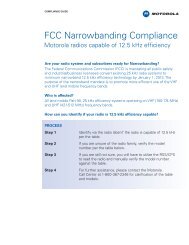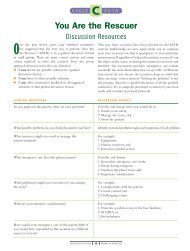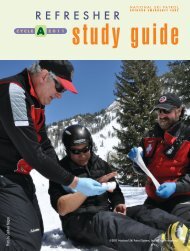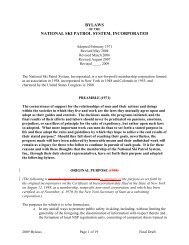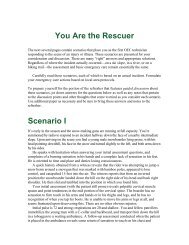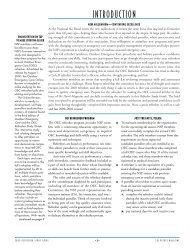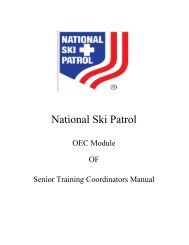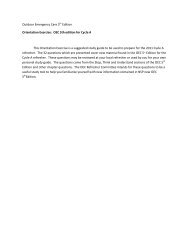Antenna Structures - Towers
Antenna Structures - Towers
Antenna Structures - Towers
You also want an ePaper? Increase the reach of your titles
YUMPU automatically turns print PDFs into web optimized ePapers that Google loves.
<strong>Antenna</strong> <strong>Structures</strong> & <strong>Towers</strong><br />
rev 5/27/11<br />
Questions regarding this information may be directed to telecom@nsp.org<br />
Most antenna structures that are taller than 60.96 meters (200 feet)<br />
above ground level or that may interfere with the flight path of a<br />
nearby airport must be cleared by the Federal Aviation Administration<br />
(FAA) and registered with the FCC.<br />
Unless specifically exempted, FAA notification and FCC registration are<br />
required for:<br />
1. Any construction or alteration of more than 60.96 meters (200<br />
feet) in height above ground level at its site.<br />
2. Any construction or alteration of greater height than an<br />
imaginary surface extending outward and upward at one of the<br />
following slopes:<br />
o 100 to 1 for a horizontal distance of 6.10 kilometers<br />
(20,000 feet) from the nearest point of the nearest runway<br />
of each specified airport with at least one runway more<br />
than 0.98 kilometers (3,200 feet) in actual length,<br />
o<br />
excluding heliports;<br />
50 to 1 for a horizontal distance of 3.05 kilometers<br />
(10,000 feet) from the nearest point of the nearest runway<br />
of each specified airport with its longest runway no more<br />
than 0.98 kilometers (3,200 feet) in actual length,<br />
excluding heliports; and,<br />
o 25 to 1 for a horizontal distance of 1.52 kilometers (5,000<br />
feet) from the nearest point of the nearest landing and<br />
takeoff area of each heliport at a specified airport.<br />
3. Any construction or alteration that would be in an instrument<br />
approach area and available information indicates it might<br />
exceed an obstruction standard of the FAA. In this case, the FAA<br />
would specifically ask you to file a notification -- you would then<br />
be required to register the structure.<br />
4. Any construction or alteration on a specified airport.<br />
The following types of antenna structures are exempt from the FAA<br />
notification requirements and FCC registration requirements:
2<br />
1. Any antenna structure that would be shielded by existing<br />
structures of a permanent and substantial character or by<br />
natural terrain or topographic features of equal or greater<br />
height, and would be located in the congested area of a city,<br />
town or settlement where it is evident beyond all reasonable<br />
doubt that the structure so shielded will not adversely affect<br />
safety in air navigation.<br />
2. Any antenna structure of 6.10 meters (20 feet) or less in height<br />
except one that would increase the height of another antenna<br />
structure. Examples of the "20 foot rule."<br />
3. Any air navigation facility, airport visual approach or landing aid,<br />
aircraft arresting device, or meteorological device, of a type<br />
approved by the FAA, the location and height of which is fixed by<br />
its function.<br />
Return to Top<br />
Examples<br />
<strong>Antenna</strong> structures mounted on man-made structures:<br />
NOTE: In order to simplify this example, we have assumed that<br />
the antenna structures are far from an airport. The same<br />
principles, however, hold true when substituting the "imaginary<br />
surface" for the 60.96 meter (200 foot) line shown in the example.<br />
(A) and (B) -- Registration is not required. Neither of these antenna<br />
structures exceeds 60.96 meters (200 feet) above ground.
3<br />
(C) -- Registration is not required. Although the tip of the structure is<br />
more than 60.96 meters (200 feet) above ground, the structure meets<br />
the 6.1 meter (20 foot) exception.<br />
(D) -- Registration IS REQUIRED. Although the structure itself does<br />
not exceed 6.1 meters (20 feet) above the building, the tip of the<br />
antenna mounted on the structure exceeds 6.1 meters (20 feet) above<br />
the building.<br />
(E) -- Registration IS REQUIRED. The structure clearly exceeds 6.1<br />
meters (20 feet) above the building.<br />
(F) -- Registration is not required. Although the antenna structure<br />
causes the overall height of the building to exceed 60.96 meters (200<br />
feet) above ground, the antenna structure meets the 6.1 meter (20<br />
foot exception). (Note -- the building owner would be responsible for<br />
notifying the FAA concerning the overall height of the building. This<br />
action would not affect the antenna structure.)<br />
Free-standing antenna structures:<br />
NOTE: In order to simplify this example, we have assumed that<br />
the antenna structures are far from an airport.The same<br />
principles, however, hold true when substituting the "imaginary<br />
surface" for the 60.96 meter (200 foot) line shown in the example.<br />
(G) -- Registration is not required. The structure does not exceed<br />
60.96 meters (200 feet) above ground.<br />
(H) -- Registration IS REQUIRED. Although the structure itself does<br />
not exceed 60.96 meters (200 feet) above ground, the antenna<br />
mounted on the top causes the overall height of the structure to<br />
exceed 60.96 meters (200 feet).
4<br />
(I) -- Registration IS REQUIRED. The structure clearly exceeds 60.96<br />
meters (200 feet) above ground.<br />
Return to Top<br />
"Specified Airports"<br />
The following airports are "specified airports" for purposes of<br />
determining whether an antenna structure meets the registration<br />
criteria:<br />
• A public use airport listed in the Airport Directory of the current<br />
Aeronautical Information Manual or in either the Alaska or Pacific<br />
Airman's Guide and Chart Supplement;<br />
• An airport under construction, that is the subject of a notice or<br />
proposal on file with the FAA, and except for military airports, it<br />
is clearly indicated that the airport will be available for public<br />
use; or<br />
• An airport that is operated by an armed force of the United<br />
States.<br />
Return to Top<br />
TOWAIR - determining the "slope" calculation<br />
To determine whether a structure penetrates the imaginary line<br />
extending outward and upward from the nearest point of the nearest<br />
airport runway, you may use the FCC's on-line Landing Facility Slope<br />
Calculation program (TOWAIR).<br />
TOWAIR, which uses FAA-supplied airport data, may be queried based<br />
on a specific set of coordinates, elevation and overall height criteria.<br />
When reviewing licensing applications to determine whether a<br />
proposed site is located on a structure that requires registration, the<br />
FCC will use the TOWAIR calculations. Therefore, if TOWAIR indicates<br />
that registration is required but you believe otherwise, you should be<br />
prepared to submit appropriate documentation in conjunction with any<br />
licensing activity at the site. Alternately, you may wish to register the<br />
structure in question.<br />
Return to Top
5<br />
Shielded <strong>Structures</strong><br />
If a structure is shielded beyond all reasonable doubt by other<br />
structures, registration is not required. In the event that one of the<br />
structures that originally shielded the antenna structure is removed,<br />
the antenna structure's owner must register the structure if it meets<br />
the notice criteria and shielding is no longer valid.<br />
If there is any doubt as to whether the exception applies, an owner<br />
should register its structure.<br />
In the case of structures that are "shielded" and do not require FAA<br />
notification or Commission registration, FCC rules require applicants to<br />
submit a showing to that effect. An owner claiming shielding does not<br />
need to submit any information as part of the <strong>Antenna</strong> Structure<br />
Registration program, but instead should be prepared to supply<br />
information sufficient to establish whether FAA notification and<br />
Commission registration is required, if so requested by the<br />
Commission.<br />
Because the FCC does not have a means to provide for automated<br />
evaluation of shielding claims, applicants for station licenses may be<br />
asked by a Bureau's licensing staff to make a showing that shielding<br />
applies for the structure upon which they intend to site.<br />
Return to Top<br />
When to Register<br />
All new or altered antenna structures meeting the registration criteria<br />
must be registered with the Commission prior to construction or<br />
alteration. All antenna structures meeting the registration criteria must<br />
first have been studied by the FAA before being registered with the<br />
Commission.<br />
"Existing structures" (those studied by the FAA and cleared by the FCC<br />
prior to July 1, 1996) were required to have been registered during the<br />
two year period between July 1, 1996 and June 30, 1998. Owners of<br />
existing structures that are unregistered but that meet the registration<br />
criteria are not in compliance with FCC regulations and must register<br />
their structures immediately.
A structure is not registered unless it has a valid seven-digit FCC<br />
Registration Number. Six-digit "Tower Numbers" pre-date the ASR<br />
program and are invalid.<br />
6



